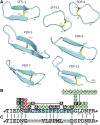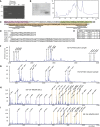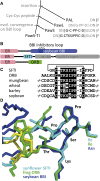Evolutionary origins of a bioactive peptide buried within Preproalbumin
- PMID: 24681618
- PMCID: PMC4001405
- DOI: 10.1105/tpc.114.123620
Evolutionary origins of a bioactive peptide buried within Preproalbumin
Abstract
The de novo evolution of proteins is now considered a frequented route for biological innovation, but the genetic and biochemical processes that lead to each newly created protein are often poorly documented. The common sunflower (Helianthus annuus) contains the unusual gene PawS1 (Preproalbumin with SFTI-1) that encodes a precursor for seed storage albumin; however, in a region usually discarded during albumin maturation, its sequence is matured into SFTI-1, a protease-inhibiting cyclic peptide with a motif homologous to unrelated inhibitors from legumes, cereals, and frogs. To understand how PawS1 acquired this additional peptide with novel biochemical functionality, we cloned PawS1 genes and showed that this dual destiny is over 18 million years old. This new family of mostly backbone-cyclic peptides is structurally diverse, but the protease-inhibitory motif was restricted to peptides from sunflower and close relatives from its subtribe. We describe a widely distributed, potential evolutionary intermediate PawS-Like1 (PawL1), which is matured into storage albumin, but makes no stable peptide despite possessing residues essential for processing and cyclization from within PawS1. Using sequences we cloned, we retrodict the likely stepwise creation of PawS1's additional destiny within a simple albumin precursor. We propose that relaxed selection enabled SFTI-1 to evolve its inhibitor function by converging upon a successful sequence and structure.
Figures





Similar articles
-
Two proteins for the price of one: Structural studies of the dual-destiny protein preproalbumin with sunflower trypsin inhibitor-1.J Biol Chem. 2017 Jul 28;292(30):12398-12411. doi: 10.1074/jbc.M117.776955. Epub 2017 May 23. J Biol Chem. 2017. PMID: 28536266 Free PMC article.
-
Stepwise Evolution of a Buried Inhibitor Peptide over 45 My.Mol Biol Evol. 2017 Jun 1;34(6):1505-1516. doi: 10.1093/molbev/msx104. Mol Biol Evol. 2017. PMID: 28333296
-
Albumins and their processing machinery are hijacked for cyclic peptides in sunflower.Nat Chem Biol. 2011 May;7(5):257-9. doi: 10.1038/nchembio.542. Epub 2011 Mar 20. Nat Chem Biol. 2011. PMID: 21423169
-
Buried treasure: biosynthesis, structures and applications of cyclic peptides hidden in seed storage albumins.Nat Prod Rep. 2018 Feb 21;35(2):137-146. doi: 10.1039/c7np00066a. Nat Prod Rep. 2018. PMID: 29379937 Review.
-
Sunflower trypsin inhibitor-1.Curr Protein Pept Sci. 2004 Oct;5(5):351-64. doi: 10.2174/1389203043379594. Curr Protein Pept Sci. 2004. PMID: 15544530 Review.
Cited by
-
Rational design of glycosaminoglycan binding cyclic peptides using cPEPmatch.Comput Struct Biotechnol J. 2024 Jul 20;23:2985-2994. doi: 10.1016/j.csbj.2024.07.016. eCollection 2024 Dec. Comput Struct Biotechnol J. 2024. PMID: 39135886 Free PMC article.
-
Bowman-Birk Inhibitors: Insights into Family of Multifunctional Proteins and Peptides with Potential Therapeutical Applications.Pharmaceuticals (Basel). 2020 Nov 25;13(12):421. doi: 10.3390/ph13120421. Pharmaceuticals (Basel). 2020. PMID: 33255583 Free PMC article. Review.
-
Recent advances in the biosynthesis of RiPPs from multicore-containing precursor peptides.J Ind Microbiol Biotechnol. 2020 Oct;47(9-10):659-674. doi: 10.1007/s10295-020-02289-1. Epub 2020 Jul 2. J Ind Microbiol Biotechnol. 2020. PMID: 32617877 Free PMC article. Review.
-
Progress toward sourcing plants for new bioconjugation tools: a screening evaluation of a model peptide ligase using a synthetic precursor.3 Biotech. 2019 Dec;9(12):442. doi: 10.1007/s13205-019-1983-2. Epub 2019 Nov 9. 3 Biotech. 2019. PMID: 31763120 Free PMC article.
-
Two proteins for the price of one: Structural studies of the dual-destiny protein preproalbumin with sunflower trypsin inhibitor-1.J Biol Chem. 2017 Jul 28;292(30):12398-12411. doi: 10.1074/jbc.M117.776955. Epub 2017 May 23. J Biol Chem. 2017. PMID: 28536266 Free PMC article.
References
-
- Allen R.D., Cohen E.A., Vonder Haar R.A., Adams C.A., Ma D.P., Nessler C.L., Thomas T.L. (1987). Sequence and expression of a gene encoding an albumin storage protein in sunflower. Mol. Gen. Genet. 210: 211–218. - PubMed
-
- Barreda V., Palazzesi L., Tellería M.C., Katinas L., Crisci J.V. (2010). Fossil pollen indicates an explosive radiation of basal Asteracean lineages and allied families during Oligocene and Miocene times in the Southern Hemisphere. Rev. Palaeobot. Palynol. 160: 102–110.
-
- Birk Y. (1985). The Bowman-Birk inhibitor. Trypsin- and chymotrypsin-inhibitor from soybeans. Int. J. Pept. Protein Res. 25: 113–131. - PubMed
Publication types
MeSH terms
Substances
LinkOut - more resources
Full Text Sources
Other Literature Sources

